[Chapter 3] Evolution of Tone Generator Systems & Approaches to Music Production
- Home
- 40th Anniversary Model
- History
- Chronology
- Product Lineup
- News
- Artist Comments
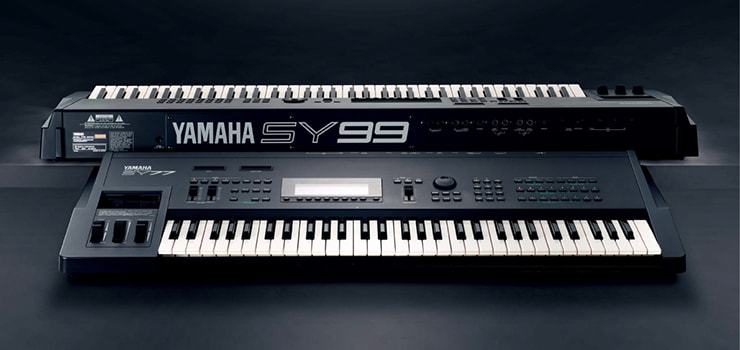
The SY77, released in 1989. Offering much greater expressive power thanks to newly-developed digital filters that duplicated the behavior of analog synths, this instrument was truly symbolic of 90s synthesizers. Released in 1991, the SY99 took this further, offering greater voice creation capabilities and making considerable strides as a workstation synth. The SY99 would also prove to be the genesis for the Yamaha workstation synths that led to the MOTIF series.
[Chapter 3] Evolution of Tone Generator Systems & Approaches to Music Production
Arrival of the sampling-based tone generators
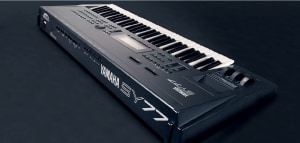
Spurred on by development of the FM tone generator, Yamaha transitioned its synthesizers to digital technologies during the 1980s, and thanks also to advances in integrated circuits, we released products with a diverse array of new functions. One part of this approach involved the development of technologies that would allow digital recordings of the actual sounds of acoustic instruments—commonly referred to as "samples"—to be used as the tone generator. Drums, percussion, effect noises, and other similar sounds are relatively short, making them ideal for sampling; furthermore, very little adjustment of pitch or timbre is required when these recordings are played back. As such, sampling technology can be applied to easily recreate the sounds of these and other acoustic instruments. For this reason, various different instrument manufacturers began to use sampling-based tone generation—also known as Pulse Code Modulation (PCM)—in drum machines and other similar products during the eighties. Here at Yamaha, we call this type of engine the Advanced Wave Memory (AWM) tone generator.
Yet this type of tone generator was not limited to drum sounds: it could also replay samples recorded from pianos, guitars, and other instruments with longer decay times, as well as the sustained sounds of organs and the like. That said, their main mode of use was as a sampler—that is, a device that replays recorded instrument sounds as–is—and they were not used in synthesizers to actually create sound. Many challenges still needed to be overcome before the Advanced Wave Memory (AWM) tone generator could also function effectively as a synth engine that allowed sounds to be designed in a creative fashion, or as part of a highly expressive instrument for live performance.
One particularly difficult task was the development of digital filters that could behave in the same way as those featured in analog synthesizers. Although the theoretical mathematical formulae that described how these devices operated were certainly well understood at the time, when replicated inside a digital circuit their behavior was much less smooth than that of the analog filter. Developers found it especially difficult to give character to "resonance," a highly distinctive feature of the analog synth. Other instrument manufacturers had already released synthesizers featuring digital filters, but the majority fell short of the mark. Many did not feature resonance at all, while others attempted to simulate this unique filter behavior in an artificial manner.
At that time, Yamaha had actually developed a digital filter capable of reproducing the behavior of an analog one, a feature that made its long awaited debut in our SY77 digital synthesizer in 1989. The SY77 was equipped with both an AWM tone generator and an FM tone generator, both of which could be used together with the digital filter to sculpt sound for remarkable levels of expression. These two new approaches to tone generation were christened Advanced Wave Memory 2 (AWM2) synthesis and Advanced Frequency Modulation (AFM) synthesis, respectively. The SY77 made it possible to create exciting sounds using a hybrid-like combination of sampling and FM, and also featured many other groundbreaking functions—for example, the PCM waves of the AWM2 engine could even be used as operator waves in the AFM tone generator.
The digital filter's cutoff frequency and resonance parameters could also be controlled using the keyboard's velocity and aftertouch, and the combination of all of these features together was referred to as the Realtime Convolution & Modulation (RCM) system. With its smooth digital filter and combination of both PCM and FM—the two giants of digital tone-generation of the time—the SY77 seemed almost too good to be true upon its release, and went on to epitomize the advanced state of synthesizer technology of the 1990s.

Left: From the cover of the SY77 catalog Right: An explanation of RCM tone generation, taken from the SY77 owner's manual
Multitimbrality

TG55
Another notable aspect of the synthesizers of the nineties was the development of multitimbral tone generators. Multitimbrality refers to the ability of an instrument to play multiple different types of sound at the same time, a capability that is indispensable in music production.
While not so important to the keyboardist performing live, multitimbral capability does allow different instrument voices such as drums, bass, piano, and solo parts to be played together. However, it really came into its own when MIDI sequencers started to become popular towards the second half of the eighties, allowing a single synthesizer to be used to create a full musical arrangement. Against this backdrop, the multitimbral synth saw increasing use in the production of full-fledged demo tapes and backing tracks for keyboardists to play along with. Although tone generators offering multitimbrality had actually existed from the slightly earlier FM era, interest in this feature increased markedly with the emergence of synthesizers capable of the high-quality, highly realistic sounds of acoustic instruments made possible by the AWM2 and other similar tone generators. At the same time, fierce competition erupted between the various synth makers as they strove to deliver products that were cheaper, could play more notes or voices simultaneously, and offered greater choice in voice variations.
Up until that time, if you had wanted to play multiple voices automatically using a MIDI sequencer, you would have had to fork out hundreds of thousands of yen to purchase enough synthesizers for the number of voices required.
Now, however, a single instrument could effortlessly produce all of these sounds simultaneously. Although various manufacturers addressed this need with tone generator modules supporting eight-part multitimbrality, our TG55 offered excellent value for money with a sixteen-part multitimbral sound system, as did the SY77 and SY55 workstations, revolutionary instruments than can be credited with vastly expanding the number of people producing music.
Evolution of our PCM synthesizers
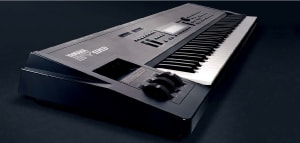
As tone generators based on sampling technologies started to become more popular, synth makers introduced various types of instrument based on PCM tone generators, making the market increasingly competitive. Yamaha responded by further enhancing the AWM2 tone generator developed for the SY77 and exploring a range of other applications.
Released a year after the SY77 in 1990, our SY55 represented a significant technological advancement, by making it possible to simultaneously use four components known as "elements," each of which produced sound using sampled waves. This approach allowed sounds to be sculpted in a highly artistic and inventive fashion—for example, one could create an original voice by combining just the attack portion of a piano with the sustained portion of a flute, or alternatively, assemble a horn-section sound from trumpet, trombone, alto sax, and tenor sax.
In parallel with these developments, effects units were also evolving at a rapid pace thanks in part to the adoption of digital technologies. The upshot was that synth owners could now process their sounds to the same high quality levels as dedicated hardware units found in professional recording studios just by using the effectors already built into their instruments,.
The SY99 introduced in 1991 could sample external sounds for use in its AWM2 tone generator. With this and other novel features, it greatly enhanced expandability and sound creation capabilities, marking a major evolutionary milestone for the PCM synthesizer. In fact, the AWM tone-generator design perfected in the first half of the nineties—together with "element" and other related terms—are used to this day in the instruments of our MOTIF Series.
Dawn of the workstation era
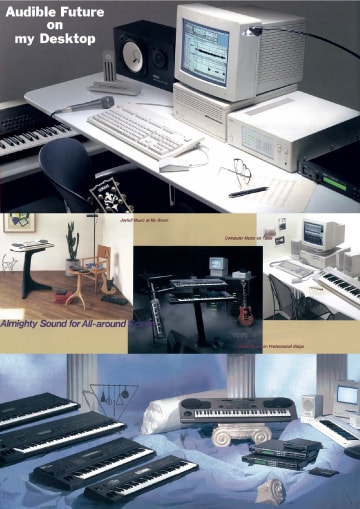
Images from the Yamaha digital instrument catalog. From the top, the 1994, 1993, and 1992 editions
From the start of the nineties, the hardware sequencers that had been used in the latter half of the preceding decade—such as those of the QX Series—were gradually replaced by computer-based software sequencers. In the recording studio, meanwhile, it became increasingly common to see a vast array of digital devices, such as MIDI interfaces connected to computers; samplers, synths, and other tone generators loaded into racks; and a master keyboard for entering performance data, all connected by a complex web of cables. Using this type of music production system with the computer at its core, a single musician could freely perform and record whatever tracks they wanted to produce a complete song in a very short time. This undeniably raised the bar to becoming a keyboard player, and it was at around this time that the course of development the synthesizer split into two different paths based on what was required of it as an instrument.
The first of these was predicated on the synth being used simply as a tone generator. Certain applications saw tone generators played using wind and guitar synths, but the prevailing trend was for them to be used as an integral part of a computer-based music production system. However, the tone generator would be controlled by the computer or another MIDI signal source, meaning that it no longer had to be integrated with a keyboard in the same way as the synthesizers of the past. To address this, Yamaha released a range of rack-mounted and desktop-type tone generators under the TG designation.
The second path saw the synth develop as a workstation capable of satisfying the requirements of both keyboardist and arranger—a format to which most of the keyboard-type synthesizers of the era adhered. Players could produce full-blown tunes using just the workstation, and with no particular computer skills, make complete productions on this single instrument without any complicated cables, be creatively inspired by studio-level high quality audio. The SY99 mentioned previously brought all of these elements together, and came to be seen as the ultimate in nineties workstations; and the SY Series as the genesis of the Yamaha workstation synthesizer.
The quest for new tone-generation techniques
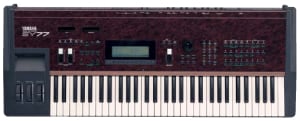
The VL1 prototype, created with a wood grain panel based on the SY77
The sampling and PCM approaches to tone generation that started to become the mainstay of sound production in synths from the beginning of the nineties have at their core the recording and playback of real instruments. High-quality recording and playback make it possible to replicate the exact same sound as the original; however, developing this into a convincing musical instrument was no easy feat, primarily because pitch and timbre must be controlled in real time in order to make these sounds playable. Consider, for example, that the piano keyboard has 88 keys and the same number of scale notes, MIDI allows the strength of playing to be represented on a 127-level scale, realistic sounds need to change over time and join with one another, and controllers must be able to modulate the sound for greater levels of expression. It is not hard to see that multiple different patterns covering all of these possibilities had to be recorded, and the most appropriate instantaneously selected for playback. This in turn called for huge volumes of recorded data to be processed by memory and processors that remained slow and expensive. In this regard, the technologies of the day left much to be desired.
Although Yamaha's FM tone generation systems could produce highly expressive sounds without the need for much memory, our synthesizer development team embarked on a quest to identify new approaches to tone generation that could create much more realistic sounds, similar to those of acoustic instruments. As a result of this effort, physical modeling was determined to be the most promising candidate.
Physical modeling is an approach to tone generation where the physical actions that actually occur when producing the sound are expressed in the form of mathematical equations, which are then used to model the overall process. If, for example, producing the sound of a saxophone, this type of tone generator would mathematically model the musician blowing air into the instrument, the blown air causing the reed to vibrate, and the sound of the vibration being amplified due to sympathetic resonance inside the body of the sax. As with FM synthesis, this method is based on a theoretical approach developed at Stanford University, with fundamental research having started back in the eighties. However, it was not until the following decade—when the development of new tone-generation systems became an urgent matter—that the Yamaha synthesizer development team of the time decided to begin R&D with the aim of converting physical modeling into a practical technology for use in synths.
It took all of the team's resources to achieve success, but their dedication ultimately paid dividends in the Virtual Acoustic (VA) tone generator—the first in the world to use physical modeling. We proudly unveiled this tone generator to the world in 1993 as the heart of the VL1 synthesizer. With just two-note polyphony, this unconventional synth contrasted starkly with the SY Series and other similar instruments from the heyday of the synthesizer, which possessed a much higher level of polyphony and were capable of simultaneously producing the sounds of multiple different instruments. Yet the VL1 stole the show with its ability to reproduce—with remarkable levels of realism—the sounds of wind instruments such as the saxophone and trumpet, as well as the violin and other string instruments. In order to do so, a signal from a sound generator known as an instrument was processed and sculpted by a modifier, which controls the sound of the instrument model. In the case of a wind instrument, for example, an instrument corresponding to the mouth piece or reed would be combined with a modifier defining the physical material or shape of whatever was being modeled.
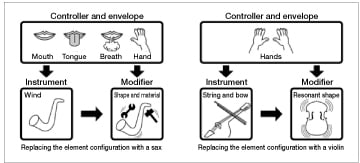
From VL1 Owner's Manual: Perfect Guide
A range of parameters unique to the VL1 could be assigned to the instrument and modifier in order to modulate their behavior, but the real driver of this synth's realistic sound was the high degree of freedom with which it could be played. Unlike the synthesizers of the past, notes were not produced just by playing the keyboard: if modeling a wind instrument, for example, the VL1 could be set to produce sounds using its breath controller—a device that changes MIDI parameters based on how hard you blow onto it. With the VL1, the musician would blow onto the breath controller exactly as if he or she was blowing into the instrument being modeled, while at the same time pressing the keys on the keyboard.
While any MIDI-compatible synth of the day would have been able to control volume using a breath controller, what made the VL1 special was the way in which it faithfully modeled instruments such as sax and trumpet to the extent that even subtle changes in tone and pitch could be produced based on how hard one blew onto the controller, all of which made for dramatically more realistic sounding performances. In fact, the wind instrument sounds produced by this synthesizer could easily be mistaken for the real thing, and its release attracted massive interest from all over the world. Subsequent models included the VL1-m, which had the VL1 as its tone generator module, and the low-cost VL70-m. Even today, these instruments are still regularly used by wind synthesizer musicians.
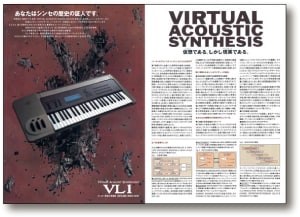
The 1994 edition of the VL1 catalog
In addition to the Self Oscillation type VA (S/VA) tone generator used in the VL1, Yamaha also developed a Free Oscillation type—the F/VA—and the VP1 virtual analog synthesizer released the following year was driven by this engine. The F/VA tone generator could model many different variations in the striking, plucking, and bowing of percussion and string instruments, but rather than being limited to simulating existing sounds, it could also model instruments that had never even been conceived of. Although the VL1 and the VP1 synthesizers were very technologically advanced and expressive, a number of different controllers, such as the breath controller, had to be played at the same time in order to perform on them, and this meant that their musicians needed to become highly skilled. For this reason, they did not become particularly popular with conventional keyboard players and remained a niche instrument.

The VL1 and VP1 (featured in the 1994 digital instrument catalog)
At the mercy of the nineties' economy

VL1-m
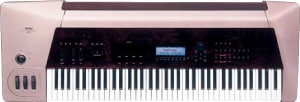
VP1
In the 1980s Yamaha established itself as a leader in the development of digital synthesizers with the groundbreaking DX Series. With the arrival of the PCM synth era in the latter half of that decade, we successfully developed the AWM2 tone generator, before moving on to the powerful SY Series. Yet all was not smooth sailing for this synth maker.
One of the biggest factors affecting our business was exchange rate fluctuation. When the DX7 was released in 1983, one US dollar was roughly equivalent to 240 Japanese yen; however, this dropped markedly to 145 yen by the time of the SY77 release in 1989. The dollar had fallen even further when we introduced the SY99 at the end of 1991, dipping below the 130 yen mark. From then until the arrival of the VP1 in 1994, the yen strengthened even further, ultimately forcing the dollar below 100 yen in value.
Back in the DX7 era, we proudly delivered high-performance synthesizers at reasonable prices to customers all over the world, but the rapid appreciation of the yen in the nineties severely eroded the price competitiveness of our products. In particular, the synthesizers that Yamaha had developed as entry level models now found themselves in the mid- to high-price brackets in overseas markets, putting them beyond the budget of the users for whom they were intended.
The collapse of the Japanese economic bubble brought further grief. The period from 1991 onward was marked by rapid economic decline in Japan, and sales of relatively expensive electronic instruments suffered greatly. Other Japanese manufacturers endured similar hardship and faced these difficult times by streamlining their product range, sharing functionality between multiple models, and reconfiguring their lineups with less expensive products.
Although the synthesizer had been born of a desire to grant the musician the same level of expressivity as afforded by acoustic instruments, advances in sampling technologies had now made it possible to produce exactly the same sounds as these instruments with ease. As a result, more importance came to be placed on the synthesizer as an alternative to acoustic instruments than on the functionality that it provided for creative sound design. Furthermore, a number of other developments had also made it easier to compare the sounds of synths from different manufacturers using the same performance data. For example, the General MIDI (GM) standard was published in 1991 for synthesizers that produce sounds in response to MIDI messages, and the Standard MIDI File (SMF) was developed as a common format for exchanging MIDI performance data. Consequently, synth buyers focused more on differences in the sounds produced and suitability to music production than on synthesizer-specific functions and playability.

W5

QS300

Taking their lead from this, other synth makers scaled back the resources committed to the development of hardware and functionality, instead channeling their efforts into the quality and diversity of the waveforms at the heart of their PCM synthesizers. That is to say, they strove to compete and differentiate themselves on the basis of digital content, and this produced steady growth in customers. In reaction to this trend of the times, Yamaha sought to get back on track via technological innovation. At the opposite end of the spectrum from the performance-oriented VL and VP models, we worked to enhance the music production functionality of our workstations. And for the more cost-conscious customers, we released our W Series in 1994, followed a year later by the QS300 synthesizer—a model that supported the XG MIDI format. The W Series synths were particularly well suited to high-quality music production with their 8 MB of wave memory (the most available at the time), six independent effect processors, 16-part multitimbrality in all situations, and GM support. Unlike the instruments of the SY Series, however, these synths found little favor with pro keyboard players.
Numerous different ideas such as the development of new tone generators, adding innovative functionality, and further enhancing our PCM tone generators were proposed in order to escape this rut, and we also planned and released a great many new products. Unfortunately, however, Yamaha was unable to keep up with rapid change in the synthesizer market and the general business environment, and we also failed to release any products that fully satisfied the needs of users. Needless to say, this exacerbated an already precarious situation for the Yamaha synth.
In the first half of the nineties, we recorded a big hit with our QY series of music sequencers, which allowed anybody to produce music practically anywhere; furthermore, the increasing popularity of the XG format made it possible for anyone to easily become a producer. In the field of synthesizers, however, despite following on from the success of our SY Series and TG Series with the release and upgrade of more than 30 different products (such as the EOS B Series, the P Series, the VL/VP Series, the W Series, the QS300, and the A7000), it became clear that the Yamaha logo was slowly being replaced both on stage and in studio. As we urgently searched for a way to overcome these difficulties, Yamaha's synthesizer business remained mired in difficulties.
